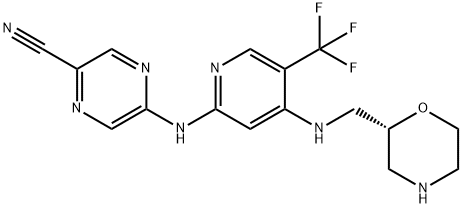SAFETY INFORMATION
| Signal word | Warning |
|---|---|
| Pictogram(s) |
 Exclamation Mark Irritant GHS07 |
| GHS Hazard Statements |
H302:Acute toxicity,oral H315:Skin corrosion/irritation H319:Serious eye damage/eye irritation H335:Specific target organ toxicity, single exposure;Respiratory tract irritation |
| Precautionary Statement Codes |
P261:Avoid breathing dust/fume/gas/mist/vapours/spray. P305+P351+P338:IF IN EYES: Rinse cautiously with water for several minutes. Remove contact lenses, if present and easy to do. Continuerinsing. |
COMPUTED DESCRIPTORS
| Molecular Weight | 379.34 g/mol |
|---|---|
| XLogP3 | 1.1 |
| Hydrogen Bond Donor Count | 3 |
| Hydrogen Bond Acceptor Count | 11 |
| Rotatable Bond Count | 5 |
| Exact Mass | 379.13684265 g/mol |
| Monoisotopic Mass | 379.13684265 g/mol |
| Topological Polar Surface Area | 108 Ų |
| Heavy Atom Count | 27 |
| Formal Charge | 0 |
| Complexity | 526 |
| Isotope Atom Count | 0 |
| Defined Atom Stereocenter Count | 1 |
| Undefined Atom Stereocenter Count | 0 |
| Defined Bond Stereocenter Count | 0 |
| Undefined Bond Stereocenter Count | 0 |
| Covalently-Bonded Unit Count | 1 |
| Compound Is Canonicalized | Yes |
PRODUCT INTRODUCTION
description
Chk1 Inhibitor SRA737 is an orally bioavailable inhibitor of checkpoint kinase 1 (chk1), with potential antineoplastic and chemosensitization activities. Upon oral administration, chk1 inhibitor SRA737 selectively binds to chk1, thereby preventing chk1 activity and abrogating the repair of damaged DNA. This may lead to an accumulation of damaged DNA, inhibition of cell cycle arrest, and induction of apoptosis. SRA737 may potentiate the cytotoxicity of DNA-damaging agents and reverse tumor cell resistance to chemotherapeutic agents. Chk1, an adenosine triphosphate (ATP)-dependent serine/threonine kinase overexpressed in a variety of cancer cell types, mediates cell cycle checkpoint control and is essential for DNA repair; it plays a key role in resistance to chemotherapeutic agents by repairing DNA damage.
